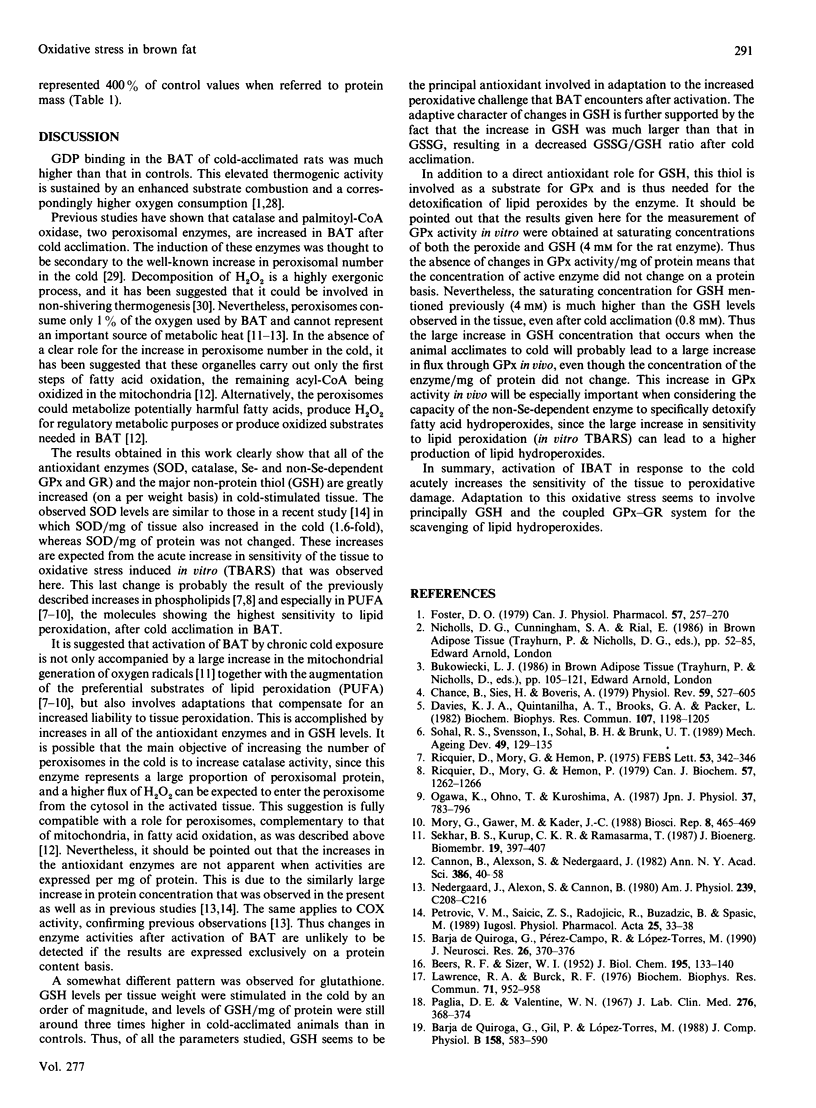Abstract
Cold acclimation increased the activities of superoxide dismutase, catalase, total and selenium (Se)-dependent glutathione peroxidases (GPx) and glutathione reductase by 2-4-fold in the brown adipose tissue (BAT) of cold-acclimated rats. Nevertheless, when expressed per unit protein, the antioxidant enzyme activities were unaltered. Sensitivity to lipid peroxidation and GSH levels both increased by one order of magnitude in the cold on a per weight basis and were still 3-5 times greater in the cold when expressed per mg of protein. We suggest that activation of BAT leads to a large increase in the potential for lipid peroxidation and that the tissue responds to this challenge by increasing practically all of its antioxidant defences. Nevertheless, GSH, and possibly GPx activity, seem to be the principal defences involved in adaptation of the tissue to a higher sensitivity to peroxidative damage after activation.
Full text
PDF



Selected References
These references are in PubMed. This may not be the complete list of references from this article.
- Ahlabo I., Barnard T. Observations on peroxisomes in brown adipose tissue of the rat. J Histochem Cytochem. 1971 Nov;19(11):670–675. doi: 10.1177/19.11.670. [DOI] [PubMed] [Google Scholar]
- BEERS R. F., Jr, SIZER I. W. A spectrophotometric method for measuring the breakdown of hydrogen peroxide by catalase. J Biol Chem. 1952 Mar;195(1):133–140. [PubMed] [Google Scholar]
- Barja de Quiroga G., Gil P., López-Torres M. Physiological significance of catalase and glutathione peroxidases, and in vivo peroxidation, in selected tissues of the toad Discoglossus pictus (Amphibia) during acclimation to normobaric hyperoxia. J Comp Physiol B. 1988;158(5):583–590. doi: 10.1007/BF00692567. [DOI] [PubMed] [Google Scholar]
- Barja de Quiroga G., Pérez-Campo R., López-Torres M. Changes on cerebral antioxidant enzymes, peroxidation, and the glutathione system of frogs after aging and catalase inhibition. J Neurosci Res. 1990 Jul;26(3):370–376. doi: 10.1002/jnr.490260314. [DOI] [PubMed] [Google Scholar]
- Cannon B., Alexson S., Nedergaard J. Peroxisomal beta-oxidation in brown fat. Ann N Y Acad Sci. 1982;386:40–58. doi: 10.1111/j.1749-6632.1982.tb21406.x. [DOI] [PubMed] [Google Scholar]
- Cannon B., Lindberg O. Mitochondria from brown adipose tissue: isolation and properties. Methods Enzymol. 1979;55:65–78. doi: 10.1016/0076-6879(79)55010-1. [DOI] [PubMed] [Google Scholar]
- Chance B., Sies H., Boveris A. Hydroperoxide metabolism in mammalian organs. Physiol Rev. 1979 Jul;59(3):527–605. doi: 10.1152/physrev.1979.59.3.527. [DOI] [PubMed] [Google Scholar]
- Davies K. J., Quintanilha A. T., Brooks G. A., Packer L. Free radicals and tissue damage produced by exercise. Biochem Biophys Res Commun. 1982 Aug 31;107(4):1198–1205. doi: 10.1016/s0006-291x(82)80124-1. [DOI] [PubMed] [Google Scholar]
- Foster D. O., Frydman M. L. Tissue distribution of cold-induced thermogenesis in conscious warm- or cold-acclimated rats reevaluated from changes in tissue blood flow: the dominant role of brown adipose tissue in the replacement of shivering by nonshivering thermogenesis. Can J Physiol Pharmacol. 1979 Mar;57(3):257–270. doi: 10.1139/y79-039. [DOI] [PubMed] [Google Scholar]
- Griffith O. W. Determination of glutathione and glutathione disulfide using glutathione reductase and 2-vinylpyridine. Anal Biochem. 1980 Jul 15;106(1):207–212. doi: 10.1016/0003-2697(80)90139-6. [DOI] [PubMed] [Google Scholar]
- LOWRY O. H., ROSEBROUGH N. J., FARR A. L., RANDALL R. J. Protein measurement with the Folin phenol reagent. J Biol Chem. 1951 Nov;193(1):265–275. [PubMed] [Google Scholar]
- Lawrence R. A., Burk R. F. Glutathione peroxidase activity in selenium-deficient rat liver. Biochem Biophys Res Commun. 1976 Aug 23;71(4):952–958. doi: 10.1016/0006-291x(76)90747-6. [DOI] [PubMed] [Google Scholar]
- Massey V., Williams C. H., Jr On the reaction mechanism of yeast glutathione reductase. J Biol Chem. 1965 Nov;240(11):4470–4480. [PubMed] [Google Scholar]
- Mory G., Gawer M., Kader J. C. Effect of noradrenaline chronic administration on brown fat phospholipids. Biosci Rep. 1988 Oct;8(5):465–469. doi: 10.1007/BF01121645. [DOI] [PubMed] [Google Scholar]
- Nava M. P., Abelenda M., Puerta M. L. Cold-induced and diet-induced thermogenesis in progesterone-treated rats. Pflugers Arch. 1990 Mar;415(6):747–750. doi: 10.1007/BF02584015. [DOI] [PubMed] [Google Scholar]
- Nedergaard J., Alexson S., Cannon B. Cold adaptation in the rat: increased brown fat peroxisomal beta-oxidation relative to maximal mitochondrial oxidative capacity. Am J Physiol. 1980 Nov;239(5):C208–C216. doi: 10.1152/ajpcell.1980.239.5.C208. [DOI] [PubMed] [Google Scholar]
- Nedergaard J., Cannon B. [3H]GDP binding and thermogenin amount in brown adipose tissue mitochondria from cold-exposed rats. Am J Physiol. 1985 Mar;248(3 Pt 1):C365–C371. doi: 10.1152/ajpcell.1985.248.3.C365. [DOI] [PubMed] [Google Scholar]
- Ogawa K., Ohno T., Kuroshima A. Muscle and brown adipose tissue fatty acid profiles in cold-exposed rats. Jpn J Physiol. 1987;37(5):783–796. doi: 10.2170/jjphysiol.37.783. [DOI] [PubMed] [Google Scholar]
- Ramasarma T. Generation of H2O in biomembranes. Biochim Biophys Acta. 1982 Aug 11;694(1):69–93. doi: 10.1016/0304-4157(82)90014-4. [DOI] [PubMed] [Google Scholar]
- Ricquier D., Mory G., Hemon P. Alterations of mitochondrial phospholipids in the rat brown adipose tissue after chronic treatment with cold or thyroxine. FEBS Lett. 1975 May 15;53(3):342–346. doi: 10.1016/0014-5793(75)80051-2. [DOI] [PubMed] [Google Scholar]
- Ricquier D., Mory G., Hemon P. Changes induced by cold adaptation in the brown adipose tissue from several species of rodents, with special reference to the mitochondrial components. Can J Biochem. 1979 Nov;57(11):1262–1266. doi: 10.1139/o79-167. [DOI] [PubMed] [Google Scholar]
- Sekhar B. S., Kurup C. K., Ramasarma T. Generation of hydrogen peroxide by brown adipose tissue mitochondria. J Bioenerg Biomembr. 1987 Aug;19(4):397–407. doi: 10.1007/BF00768542. [DOI] [PubMed] [Google Scholar]
- Sohal R. S., Svensson I., Sohal B. H., Brunk U. T. Superoxide anion radical production in different animal species. Mech Ageing Dev. 1989 Aug;49(2):129–135. doi: 10.1016/0047-6374(89)90096-1. [DOI] [PubMed] [Google Scholar]
- Tietze F. Enzymic method for quantitative determination of nanogram amounts of total and oxidized glutathione: applications to mammalian blood and other tissues. Anal Biochem. 1969 Mar;27(3):502–522. doi: 10.1016/0003-2697(69)90064-5. [DOI] [PubMed] [Google Scholar]
- YONETANI T., RAY G. S. STUDIES ON CYTOCHROME OXIDASE. VI. KINETICS OF THE AEROBIC OXIDATION OF FERROCYTOCHROME C BY CYTOCHROME OXIDASE. J Biol Chem. 1965 Aug;240:3392–3398. [PubMed] [Google Scholar]


